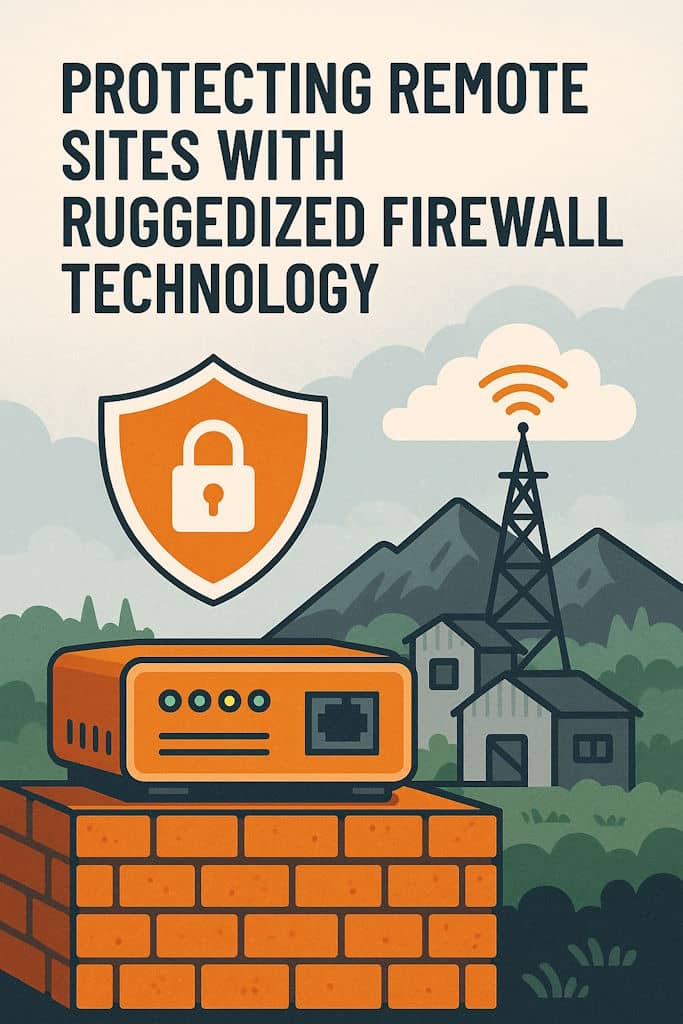Introduction
Remote sites have become critical operational hubs for industries like oil and gas, utilities, transportation, and manufacturing. From offshore oil rigs to isolated wind farms, these locations often operate in harsh environments with extreme weather, dust, and fluctuating power conditions.
Unlike corporate offices with dedicated IT teams on-site, many remote locations are unmanned for long periods. This lack of constant oversight makes them attractive targets for both cyber and physical threats. Furthermore, the sensitive operational technology (OT) systems deployed in these sites control essential processes, meaning any breach can have severe financial, environmental, and safety consequences.
Unfortunately, standard enterprise firewalls are not designed to withstand the extreme physical conditions or connectivity challenges found in remote deployments. This is where ruggedized firewall technology comes in-delivering industrial-strength resilience and robust security capabilities tailored for these demanding environments.
Understanding Ruggedized Firewall Technology
Ruggedized firewalls are purpose-built network security devices designed to operate reliably in physically challenging locations. They offer the same core cybersecurity features as enterprise firewalls but are engineered to withstand heat, cold, dust, humidity, and vibration.
Compared to standard firewalls, ruggedized versions often feature reinforced metal casings, industrial-grade components, extended temperature tolerances, and protection against electrical interference. They also prioritize stable performance even when deployed in areas with unreliable network connections.
One of the defining traits of these solutions is their ability to provide consistent, advanced security in environments where normal devices would fail. A rugged firewall for end-to-end security consistency ensures the same level of protection for remote facilities as it does for a main data center, without compromising reliability due to environmental conditions.
In addition, ruggedized firewalls are essential for industries that cannot afford downtime-where a security lapse or device failure could halt production, compromise safety, or even endanger lives.
Common Security Challenges for Remote Sites
Remote sites face a unique blend of physical and cyber risks, making security more complex than in traditional corporate settings. Some of the most pressing challenges include:
Limited physical security:
Remote locations are often unmanned and vulnerable to tampering or theft.
Unreliable connectivity:
Many sites rely on satellite or cellular networks with fluctuating speeds and availability.
Increased cyberattack exposure:
Industrial control systems (ICS) and supervisory control and data acquisition (SCADA) systems are high-value targets for attackers.
Monitoring difficulties:
Without on-site staff, early detection and response to security incidents can be delayed.
These factors mean that a robust, self-sufficient security solution-capable of operating under less-than-ideal conditions-is essential.
Core Features of Ruggedized Firewalls
Modern ruggedized firewalls are packed with specialized features to address both cybersecurity and environmental resilience:
Industrial-grade design:
Durable metal casings, shock and vibration resistance, weather-sealing, and EMI protection.
Advanced threat protection:
Real-time intrusion prevention, malware detection, and DDoS mitigation capabilities.
Secure VPN support:
Encrypted tunnels for safe remote access to OT and IT systems.
Integrated redundancy:
Dual power supplies, failover connections, and load balancing to ensure continuous availability.
Low-power operation:
Optimized for sites with limited or backup power sources.
How Ruggedized Firewalls Protect Remote Infrastructure
A ruggedized firewall acts as the primary defense layer between a remote site's network and potential threats. Its protection extends to:
Securing data transfers between field devices, sensors, and central control systems.
Preventing unauthorized access to OT networks through identity-based access control.
Enforcing Zero Trust principles in distributed, vulnerable environments.
Providing actionable alerts and logs for proactive monitoring and forensic analysis.
In critical operations such as power distribution, even a few minutes of network downtime or intrusion can cause significant service disruption. Ruggedized firewalls help maintain operational continuity and safety.
Deployment Scenarios
Ruggedized firewalls are used across a range of industries and environments:
Energy Sector:
Protecting offshore oil platforms, remote solar installations, and wind turbines.
Utilities:
Securing water treatment facilities and electrical substations.
Transportation:
Guarding traffic control systems, railway signal networks, and port operations.
Manufacturing:
Protecting remote warehouses and automated production facilities.
Integration with Centralized Security Management
One of the biggest advantages of modern ruggedized firewalls is their ability to integrate with centralized management systems. This allows IT and security teams to:
Deploy updates and patches remotely using cloud-based orchestration tools.
Monitor performance and detect threats in real time via a Security Operations Center (SOC).
Leverage AI-powered analytics to spot anomalies before they escalate into incidents.
Platforms like MITRE ATT&CK frameworks can be integrated for improved threat detection strategies, further strengthening the security posture of remote environments.
Best Practices for Implementing Ruggedized Firewalls
To maximize effectiveness, organizations should follow these best practices:
Conduct a site risk assessment to identify environmental and network vulnerabilities.
Choose certified hardware that meets industry ruggedness standards such as IP65, IP67, or NEMA ratings.
Ensure redundancy in hardware and network paths to prevent outages.
Apply regular updates and patches to keep security protocols up to date.
Regulatory Compliance and Industry Standards
Ruggedized firewalls can help organizations comply with OT security guidelines, such as:
- NIST Cybersecurity Framework for critical infrastructure.
- IEC 62443 standards for industrial automation systems.
- NERC CIP compliance for electric utilities.
Adhering to these standards ensures that security investments not only protect operations but also meet legal and regulatory obligations.
The Future of Ruggedized Firewall Technology
The next generation of ruggedized firewalls will incorporate:
AI and machine learning for autonomous threat detection and mitigation.
Edge computing capabilities for faster decision-making at remote sites.
5G integration to provide high-speed, low-latency connectivity even in isolated locations.
As remote infrastructure becomes more connected, the ability to combine physical durability with advanced cybersecurity features will be critical.
Conclusion
Ruggedized firewall technology is no longer optional for industries operating in harsh environments-it is a necessity. These devices provide the durability and security capabilities required to keep critical systems running without compromise.
By investing in ruggedized solutions, organizations can ensure operational continuity, reduce risk, and maintain compliance-regardless of how remote or challenging the environment may be.
FAQs
Q1: How do ruggedized firewalls differ from traditional firewalls in terms of durability?
Ruggedized firewalls are designed with industrial-grade materials, weather resistance, and shock protection, allowing them to function reliably in extreme environments where traditional firewalls would fail.
Q2: Can ruggedized firewalls work in areas with poor internet connectivity?
Yes. Many ruggedized models support multiple connectivity options, including LTE, 5G, and satellite, along with intelligent failover for uninterrupted service.
Q3: Are ruggedized firewalls suitable for both IT and OT security?
Absolutely. They provide layered security controls that protect both information technology (IT) systems and operational technology (OT) environments from cyber threats.








